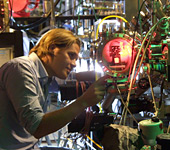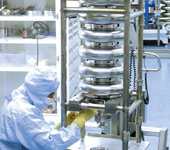Sciences

Synchrotron light sources
Particle physicists originally built electron accelerators to explore the fundamental nature of matter. At first, they looked on the phenomenon of synchrotron radiation as a troublesome problem that sapped electrons' acceleration energy. However, they soon saw the potential to use this nuisance energy loss as a new and uniquely powerful tool to study biological molecules and other materials. Now, at facilities around the world, researchers use the ultra-powerful X-ray beams of dedicated synchrotron light sources to create the brightest lights on earth, 30 times more powerful than the sun and focused on a pinpoint. These luminous sources provide tools for protein structure analysis, pharmaceutical research and drug development, real-time visualization of chemical reactions and biochemical processes, materials science, semiconductor circuit lithography, and historical research and the restoration of works of art.

Spallation neutron sources
Using accelerator technologies, spallation neutron sources produce powerful neutron beams by bombarding a mercury target with energetic protons from a large accelerator complex. The protons excite the mercury nuclei in a reaction process called spallation, releasing neutrons that are formed into beams and guided to neutron instruments. Using these sophisticated instruments, scientists and engineers explore the most intimate structural details of a vast array of novel materials.

Analytic tools
Particle physicists have developed theoretical and experimental analytic tools and techniques that find applications in other scientific fields and in commerce. Renormalization group theory first developed to rigorously describe particle interactions has found applications in solid state physics and superconductivity. Nuclear physics uses chiral Lagrangians, and string theory has contributed to the mathematics of topology. Experimental physicists have also made contributions through the development of tools extracting weak signals from enormous backgrounds and for handling very large data sets. Scientists trained in particle physics have used neural networks in neuroscience to investigate the workings of the retina and in meteorology to measure raindrop sizes with optical sensors.
- Last modified
- 05/01/2014
- email Fermilab








